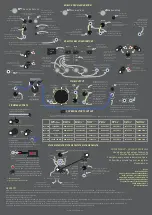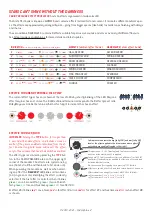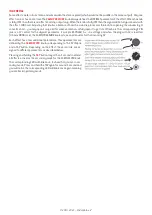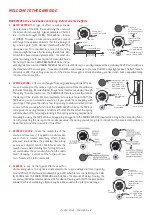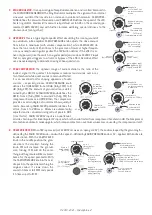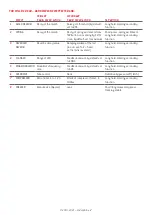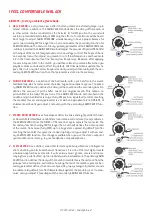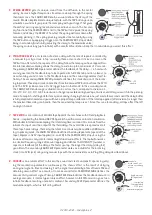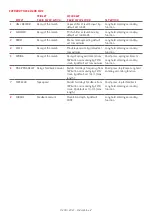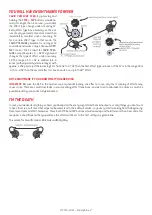
© 2010-2021 – Endorphin.es®
5. RING MODULATOR:
It is a special type of amplitude moduation and is called 'balanced' in
the FURTHRRRR GENERATOR. The Ring Modulator multiplies the signal with an internal
sine wave oscillator that results in an increase in side-band harmonics. CABIN PRES-
SURE defines the amount of modulation and CABIN FEVER defines the speed of the LFO.
Secret ingredient: Feedback! Its amount is by default set to 50% on the secondary pa-
rameter (CABIN FEVER) and with further increase will bring special dirtiness to the
drum sounds (or any other).
6. OVERDRIVE
This is a typical guitar pedal effect simulating the creamy sound of
an overdriven tube amplifier. CABIN PRESSURE knob adjusts the drive amount
from initial to maximum (with volume compensation), while CABIN FEVER de-
fines the tone control. Either it boosts the presence of lower or higher frequen-
cies as usually found in guitar pedals. The TAP button defines if the effect is ac-
tive or bypassed (like the switch on a guitar pedal) and so does FEVER CV input
that accepts gates/triggers to activate or bypass of the effect. Overdrive effect
uses 4x oversampling to eliminate aliasing at heavy distortion.
7. PEAK COMPRESSOR:
The dynamic range of audio material is the ratio of the
loudest signal to the quietest. A Compressor reduces loud sounds over a cer-
tain threshold while quiet sounds remain unaffected.
It is an essential tool for shaping dynamics of audio
sources – especially drums. CABIN PRESSURE knob
defines the THRESHOLD from -90 dB (fully CCW) to 0
dB (fully CW). The amount of gain reduction is deter-
mined by the RATIO. The CABIN FEVER knob defines the
RATIO: from 1 (fully CCW) to around 25 (fully CW) the
compressor becomes a LIMITER then. The compressor
provides a certain degree of control over how quickly it
reacts. Secondary CABIN FEVER parameter defines the
attack, from 1 to 200 msec. Release is automatically
adjusted and is calculated using ratio of peak to RMS
(crest factor). CABIN FEVER CV input is an unattenuat-
ed side-chain input for linear bipolar CV input, which is then subtracted from compressor threshold in dB. The Compressor
also features automatic makeup-gain, which compensates for an eventual volume-loss caused by the compression itself.
8. FREEZER/LOOPER:
When TAP is pressed (or FEVER CV receives an 'open gate' CV), the audio is looped by the grain length –
defined by the CABIN FEVER knob – and with the speed – defined by CABIN PRESSURE knob or CV – applied. Both knobs are
bi-directional: With the CABIN FEVER
knob in the middle position the gran-
ule size is the smallest. Turning the
knob CW will increase the granule
size; turning CCW will do the same
thing, but the granule will be reversed.
Same for the speed parameter: With
the CABIN PRESSURE knob in the mid-
dle position the speed is matching the
original sound. It slows down the
sound 5 times at full CCW and speeds
it 5 times up at full CW.
long hold
more than 1 sec
enters secondary
mode
feedback amount,
50% by default
no
feedback
continuing
CV modulation
(LFO rate)
from primary mode
short hold turns
bypass on/off
(no secondary)
gate/trigger input
bypas on/off
(together with TAP
button
more HF
(above 1kHz)
more LF
(below 1kHz)
tone control:
min.
attack 1ms
long hold
more than 1 sec
enters secondary
parameter
primary
parameter:
ratio level,
25:1 at full CW
1:1
unattenuated
side chain CV
+/-5V input range
compressor's
attack, max. 100ms
threshold
0 db at full CW
-90 db
0...+5V momentary
gate input turns
on audio freezing
up to 5
times faster
(full CW)
down to 5
times slower
(full CCW)
long hold
enables or disables
all channels from
global freezing
manual speed
of grain
playback
during freezing
CV control over
grain playback
speed
(-5V...+5V range)
manual press
momentary turns
on audio freezing
manuall choice of the grain
size from the center:
- CW: up to 2 seconds direct
- CCW up to 2 seconds in reverse
original speed


